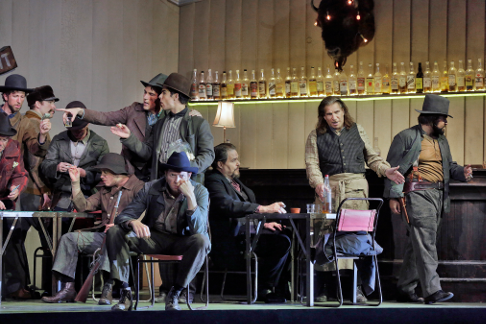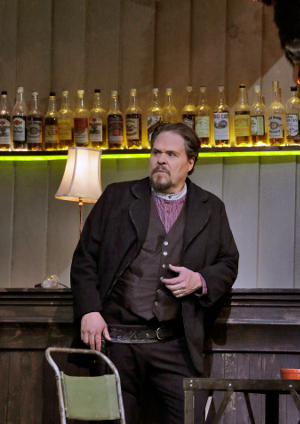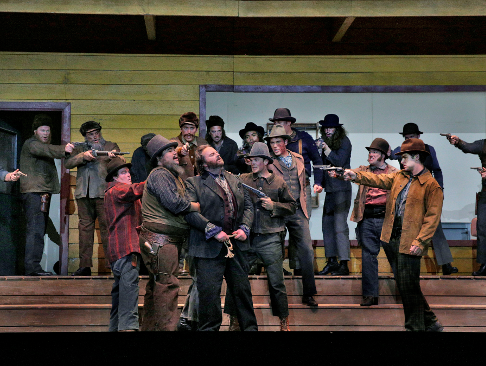![Gwyn Hughes Jones (Dick Johnson) and Patricia Racette (Minnie) [Photo © Ken Howard]](http://www.operatoday.com/15%20Gwyn%20Hughes%20Jones%20%28Dick%20Johnson%29%20and%20Patricia%20Racette%20%28Minnie%29%20in%20%27The%20Girl%20of%20the%20Golden%20West%27%20%28c%29%20Ken%20Howard%20for%20Santa%20Fe%20Opera%2C%202016.jpg.png)
09 Aug 2016
Racette’s Golden Girl in New Mexico
Fan interest began raging when Santa Fe Opera engaged venerable artist Patricia Racette to make her role debut as Minnie in Puccini’s La Fanciulla del West.
English Touring Opera are delighted to announce a season of lyric monodramas to tour nationally from October to December. The season features music for solo singer and piano by Argento, Britten, Tippett and Shostakovich with a bold and inventive approach to making opera during social distancing.
This tenth of ten Live from London concerts was in fact a recorded live performance from California. It was no less enjoyable for that, and it was also uplifting to learn that this wasn’t in fact the ‘last’ LfL event that we will be able to enjoy, courtesy of VOCES8 and their fellow vocal ensembles (more below …).
Ever since Wigmore Hall announced their superb series of autumn concerts, all streamed live and available free of charge, I’d been looking forward to this song recital by Ian Bostridge and Imogen Cooper.
Although Stile Antico’s programme article for their Live from London recital introduced their selection from the many treasures of the English Renaissance in the context of the theological debates and upheavals of the Tudor and Elizabethan years, their performance was more evocative of private chamber music than of public liturgy.
Evidently, face masks don’t stifle appreciative “Bravo!”s. And, reducing audience numbers doesn’t lower the volume of such acclamations. For, the audience at Wigmore Hall gave soprano Elizabeth Llewellyn and pianist Simon Lepper a greatly deserved warm reception and hearty response following this lunchtime recital of late-Romantic song.
For this week’s Live from London vocal recital we moved from the home of VOCES8, St Anne and St Agnes in the City of London, to Kings Place, where The Sixteen - who have been associate artists at the venue for some time - presented a programme of music and words bound together by the theme of ‘reflection’.
'Such is your divine Disposation that both you excellently understand, and royally entertaine the Exercise of Musicke.’
‘And there was war in heaven: Michael and his angels fought against the dragon; and the dragon fought and his angels, And prevailed not; neither was their place found any more in heaven … that old serpent … Satan, which deceiveth the whole world: he was cast out into the earth, and his angels were cast out with him.’
There was never any doubt that the fifth of the twelve Met Stars Live in Concert broadcasts was going to be a palpably intense and vivid event, as well as a musically stunning and theatrically enervating experience.
‘Love’ was the theme for this Live from London performance by Apollo5. Given the complexity and diversity of that human emotion, and Apollo5’s reputation for versatility and diverse repertoire, ranging from Renaissance choral music to jazz, from contemporary classical works to popular song, it was no surprise that their programme spanned 500 years and several musical styles.
The Academy of St Martin in the Fields have titled their autumn series of eight concerts - which are taking place at 5pm and 7.30pm on two Saturdays each month at their home venue in Trafalgar Square, and being filmed for streaming the following Thursday - ‘re:connect’.
The London Symphony Orchestra opened their Autumn 2020 season with a homage to Oliver Knussen, who died at the age of 66 in July 2018. The programme traced a national musical lineage through the twentieth century, from Britten to Knussen, on to Mark-Anthony Turnage, and entwining the LSO and Rattle too.
With the Live from London digital vocal festival entering the second half of the series, the festival’s host, VOCES8, returned to their home at St Annes and St Agnes in the City of London to present a sequence of ‘Choral Dances’ - vocal music inspired by dance, embracing diverse genres from the Renaissance madrigal to swing jazz.
Just a few unison string wriggles from the opening of Mozart’s overture to Le nozze di Figaro are enough to make any opera-lover perch on the edge of their seat, in excited anticipation of the drama in music to come, so there could be no other curtain-raiser for this Gala Concert at the Royal Opera House, the latest instalment from ‘their House’ to ‘our houses’.
"Before the ending of the day, creator of all things, we pray that, with your accustomed mercy, you may watch over us."
The doors at The Metropolitan Opera will not open to live audiences until 2021 at the earliest, and the likelihood of normal operatic life resuming in cities around the world looks but a distant dream at present. But, while we may not be invited from our homes into the opera house for some time yet, with its free daily screenings of past productions and its pay-per-view Met Stars Live in Concert series, the Met continues to bring opera into our homes.
Music-making at this year’s Grange Festival Opera may have fallen silent in June and July, but the country house and extensive grounds of The Grange provided an ideal setting for a weekend of twelve specially conceived ‘promenade’ performances encompassing music and dance.
There’s a “slide of harmony” and “all the bones leave your body at that moment and you collapse to the floor, it’s so extraordinary.”
“Music for a while, shall all your cares beguile.”
The hum of bees rising from myriad scented blooms; gentle strains of birdsong; the cheerful chatter of picnickers beside a still lake; decorous thwacks of leather on willow; song and music floating through the warm evening air.
![Gwyn Hughes Jones (Dick Johnson) and Patricia Racette (Minnie) [Photo © Ken Howard]](http://www.operatoday.com/15%20Gwyn%20Hughes%20Jones%20%28Dick%20Johnson%29%20and%20Patricia%20Racette%20%28Minnie%29%20in%20%27The%20Girl%20of%20the%20Golden%20West%27%20%28c%29%20Ken%20Howard%20for%20Santa%20Fe%20Opera%2C%202016.jpg.png)
Fan interest began raging when Santa Fe Opera engaged venerable artist Patricia Racette to make her role debut as Minnie in Puccini’s La Fanciulla del West.
The part is after all, a Big Sing, and poses interpretive spinto requirements that challenge many a skillful soprano. To no one’s surprise, Ms. Racette mined gold out of the heroine’s wealth of diverse musico-dramatic material.
Indeed, It was hard to believe that this was her first outing with Fanciulla, such was her well-rounded understanding and highly effective communication of the role. Her instrument remains one of the most responsive and secure in operadom, and she possesses a distinctive womanly warmth from the lower to upper middle ranges that is impossible to resist.
She can be engagingly conversational one minute and highly excitable the next. When called upon, she can hurl out gleaming phrases above the staff that ring out thrillingly above the large orchestra. If she occasionally pushes the upper voice ‘just’ beyond its natural limit, it is always in heat-of-the-moment service to the drama. The love duet was meltingly voiced, and Patricia spun out filigrees of perfection in the Bible reading scene. In short, Patricia Racette is already among the top Minnie’s of our day, and from this starting point of ‘triumphant’ she is only going to get even better.
 Ensemble cast
Ensemble cast
Mark Delavan seems born to play Jack Rance. His oversize presence and stage personality are wedded to an imposing, rock-solid, dark hued baritone. That awesome total package results in a perfect fit for the demands of the unyielding, unseemly, and unpleasant sheriff Jack Rance. This is my favorite role assumption to date for this accomplished, seasoned singer. Rance allows Mr. Delavan to show off all of his many strengths, and he proves an unrelenting vocal powerhouse. The intensity that he and Ms. Racette achieved in the famed Poker Scene was a model of its kind.
The full house seemed to enthusiastically enjoy brawny tenor Gwyn Hughes Jones even more than I did as Dick Johnson. There is much to admire in his evenly produced, heavy lyric tenor. He is especially wonderful when he is letting his clean, pleasing tone flow forth effortlessly with good legato. Mr. Hughes Jones has a bit less success when the going gets heavier, occasionally bearing down so that his lovely sound gets harder and less sympathetic. He was especially moving as he scored all the musical and emotional points in Ch’ella mi creda.
Allan Glassman offered a consistently interesting personality as the bar owner Nick, and his reliable tenor was deployed with insight and meaningful dramatic intent. Craig Verm’s rich, full-throated baritone made Sonora an important component in the evening’s success. It was luxury casting to have Raymond Aceto to lavish the part of Ashby with powerful phrasings from his pointed, polished bass-baritone.
 Mark Delavan (Jack Rance)
Mark Delavan (Jack Rance)
The entire gifted ensemble worked hard and well. Under Susanne Sheston’s assured leadership, choral singing was of a high standard. The many cameos were so well realized that it may be odious to single out any few. That said, Nicholas Davis’ rolling, mellifluous baritone made a significant impression as Jake; Adrian Smith’s well-voiced Larkens was memorably affecting; and Allen Higgs’ urgent, focused baritone made the most of his stage time as José Castro. Even the most thankless roles in the opera were well-served, with Kristen Choi bringing an appealing mezzo to Wowkle and James Harrington summoning bold, secure baritone singing as Billy Jackrabbit.
The most often heard comment the whole week I was at Santa Fe Opera: When you are doing an opera about the Golden West, and you have a stage with a back wall open to a genuine vista of ‘golden west’ hills, why cover up that natural match with a set? (And a not very atmospheric set at that.)
Well, the answer seems to be that this was a collaboration with English National Opera whose home theatre (the Coliseum) does not have nature’s scenery available (St. Martin’s Lane, anyone?) Still, set designer Miriam Buether has crafted a rather garish Polka Saloon that appears more a warehouse with spare appointments than an evocative Old West tavern. Indeed, once Mimi Jordan Sherin began her lighting design with sickly, day-glo green lighting, the place started out looking more like a wannabe hipster bar on the Vegas Strip. Once past that first impression, Ms. Sherin mellowed the look to an effective, unobtrusive collection of area washes and isolated specials.
Crowded placement of tables and chairs, with only one entrance upstage behind them, made for congested movement, and stymied a successful star entrance for Minnie. Still, the separate dance hall stage right and the secure room for the safe stage left were good touches even though they too lacked meaningful detail. Minnie’s cabin looked like a two-story Ikea dollhouse, all tidy and blond with clean angles. The wide upstage windows were covered by a drape that kept getting pulled open and closed, and the table and two chairs kept getting moved around with no tangible motivation. Curiously, the sound effect of wind gusts stayed at the same volume even when the door was opened or closed during a cue.
 Gwyn Hughes Jones (Dick Johnson) and ensemble cast
Gwyn Hughes Jones (Dick Johnson) and ensemble cast
Act Three was not in the “Great Californian Forest at Dawn,” as specified in the script but rather on the wooden front porch/façade of the sheriff’s office building. This had a couple of steps what were used for rather formal choral groupings. The gun rack on the wall in Rance’s office, and the plethora of guns being trained on Johnson in this act began to seem like a commentary on the profusion of weapons in the US.
Nicky Gillibrand’s successful costumes were appropriately character-specific. Minnie’s Act Two ‘dress up’ look was not only fun but also meaningful. Ms. Gillibrand’s somewhat stereotypical ‘black’ attire for Rance was a witty, ironic comment on old west villains.
Richard Jones made interesting decisions in his staging and he was quite effective in scenes with smaller number of characters where he fostered good interaction, motivated blocking, and useful subtext. When Mr. Jones had to move larger numbers of people in Act One, he often left them clustered and cluttered, with an appearance of imprecise traffic control. Conversely, Act Three’s crowd scene was by turns too neat (with even lines of miners on the platforms), or too messily ‘violent’ to the point of being laughable. When Johnson gets methodically passed down the forward line of men from stage right to left, getting individually punched, kneed, and brutalized, I couldn’t help but think of that scene in Airplane, in which fellow passengers line up to take their turn at slapping a seatmate out of her hysteria.
Lucy Burge’s choreography for the miners’ dancing together in Act One was well coordinated and charming. However, having the group of men get on those Act Three steps like a show choir, raise a pistol in unison in their right hand and then, en masse, execute something that was a cross between The Pony and Arsenio Hall’s fist bumps was just plumb silly, totally out of character and context.
Best for last: the Santa Fe Opera orchestra was in absolutely superb form. From the first hammered chords, Emmanuel Villaume was firmly, thrillingly in charge of a reading that was stunning from initial downbeat to finale cut-off. The Maestro was a cunning Pied Piper, leading his amassed forces with meticulous dramatic intent and unfaltering attention to detail, whether nurturing articulate solo statements, or guiding lush ensembles (oh, those gorgeous tutti strings!). Under Villaume, the band and cast rose to meet every atmospheric requirement that Puccini (and Puccinians) could dare to wish.
James Sohre
Cast and production details:
Nick: Allan Glassman; Joe: Tyson Miller; Handsome: Jared Bybee; Harry: Derrek Stark; Happy: Andrew Paulson; Sid: Jorge Espino; Sonora: Craig Verm: Trin: John Matthew Myers; Larkens: Adrian Smith; Jack Rance: Mark Delavan; Jake Wallace: Nicholas Davis; Ashby: Raymond Aceto; Minnie: Patricia Racette; Courier: Benjamin Werley; Dick Johnson: Gwyn Hughes Jones; José Castro: Alan Higgs; Wowkle: Kristen Choi; Billy Jackrabbit: James Harrington; Conductor: Emmanuel Villaume; Director: Richard Jones; Set Design: Miriam Buether; Costume Design: Nicky Gillibrand; Lighting Design: Mimi Jordan Sherin; Choreography: Lucy Burge; Fight Directors: Rick Sordelet, Christian Kelly-Sordelet; Chorus Master: Susanne Sheston.